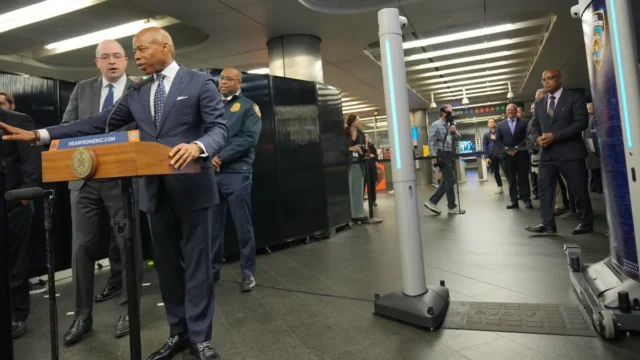
In a significant move aimed at enhancing public safety, New York City is set to introduce AI-powered metal detectors across its subway system. This initiative, announced by Mayor Eric Adams, represents a pioneering step towards leveraging technology in crime prevention within one of the world’s largest public transportation networks.
Key Highlights:
- AI-powered metal detectors will be introduced as part of a pilot crime-fighting program.
- The initiative aims to detect illegal guns and knives, addressing public safety concerns.
- Concerns have been raised regarding the technology’s accuracy and the potential for false alerts.
- The cost of implementing this technology across the subway system could be substantial, raising questions about fiscal responsibility and effectiveness.
The decision to deploy AI metal detectors comes in response to a series of subway shootings and a broader concern over weapons in public spaces. This technology, primarily sourced from Evolv Technology, is expected to streamline security screenings, reduce the need for manual checks, and enhance the detection of potential threats. However, the implementation has sparked a dialogue regarding the effectiveness and reliability of such advanced systems.
Technology and Testing Concerns
The Evolv system, chosen for its potential to offer a less intrusive and faster screening process, has not been without its critics. Trials and customer feedback have highlighted issues with false alerts, where everyday items such as laptops have triggered the system. While adjustments can be made to reduce such incidents, they raise concerns about the balance between security and convenience, especially in a bustling environment like the NYC subway.
Moreover, the system’s cost-effectiveness and operational transparency have been subjects of debate. With subscription costs for the Evolv scanners ranging between $2,000 and $3,000 per month per scanner, the financial implications for a citywide rollout are significant. Critics argue that the lack of detailed performance data and the potential impact on subway operations and rider experience warrant careful consideration before a full-scale implementation.
Practical Considerations and Public Response
The practicality of integrating such technology in a high-traffic, diverse environment as the NYC subway presents another layer of complexity. With millions of riders each day carrying various personal items, the potential for high rates of false alerts could lead to bottlenecks and delays, undermining the system’s efficiency and user satisfaction.
Public response to the announcement has been mixed, with some praising the focus on safety, while others express skepticism about the technology’s readiness and the prioritization of resources. The debate underscores the challenge of balancing security measures with operational practicality and fiscal responsibility in one of the world’s most iconic public transit systems.
As NYC moves forward with this pilot program, the outcomes will be closely watched. Success will depend not only on the technology’s ability to improve safety without significant drawbacks but also on the administration’s ability to address the concerns of stakeholders, including riders, security experts, and fiscal watchdogs.
This initiative marks a critical juncture in the city’s approach to public safety, blending traditional security measures with cutting-edge technology. Whether this “Sputnik moment,” as Mayor Adams described, will lead to a safer, more efficient subway system remains to be seen.








